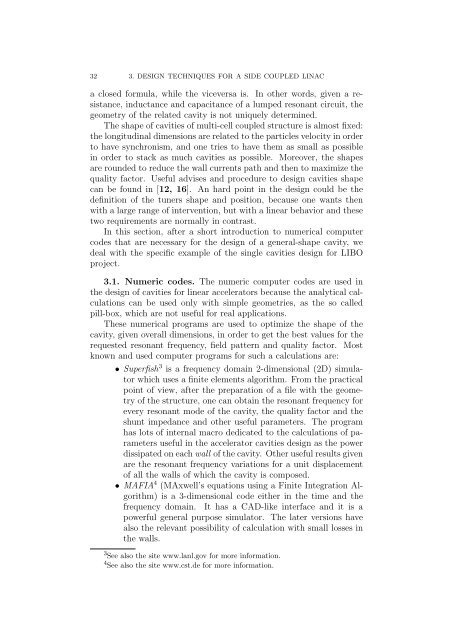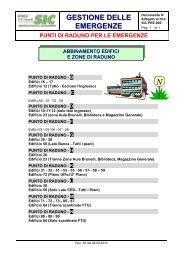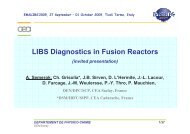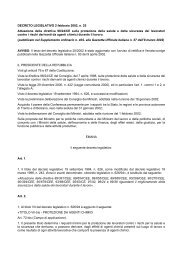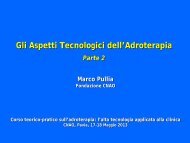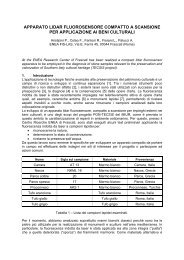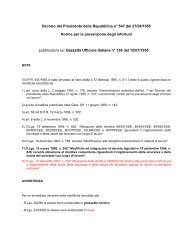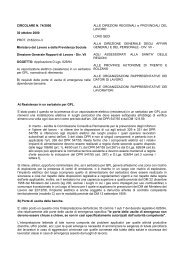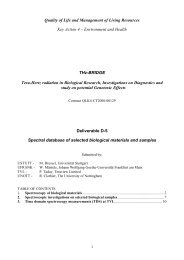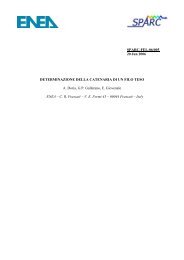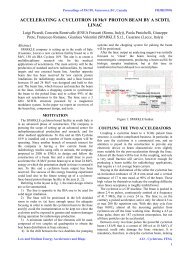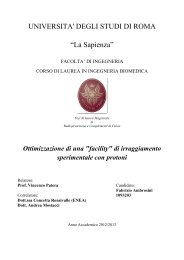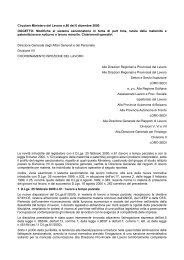Theory, Design and Tests on a Prototype Module of a Compact ...
Theory, Design and Tests on a Prototype Module of a Compact ...
Theory, Design and Tests on a Prototype Module of a Compact ...
Create successful ePaper yourself
Turn your PDF publications into a flip-book with our unique Google optimized e-Paper software.
32 3. DESIGN TECHNIQUES FOR A SIDE COUPLED LINAC<br />
a closed formula, while the viceversa is. In other words, given a resistance,<br />
inductance <str<strong>on</strong>g>and</str<strong>on</strong>g> capacitance <strong>of</strong> a lumped res<strong>on</strong>ant circuit, the<br />
geometry <strong>of</strong> the related cavity is not uniquely determined.<br />
The shape <strong>of</strong> cavities <strong>of</strong> multi-cell coupled structure is almost fixed:<br />
the l<strong>on</strong>gitudinal dimensi<strong>on</strong>s are related to the particles velocity in order<br />
to have synchr<strong>on</strong>ism, <str<strong>on</strong>g>and</str<strong>on</strong>g> <strong>on</strong>e tries to have them as small as possible<br />
in order to stack as much cavities as possible. Moreover, the shapes<br />
are rounded to reduce the wall currents path <str<strong>on</strong>g>and</str<strong>on</strong>g> then to maximize the<br />
quality factor. Useful advises <str<strong>on</strong>g>and</str<strong>on</strong>g> procedure to design cavities shape<br />
can be found in [12, 16]. An hard point in the design could be the<br />
definiti<strong>on</strong> <strong>of</strong> the tuners shape <str<strong>on</strong>g>and</str<strong>on</strong>g> positi<strong>on</strong>, because <strong>on</strong>e wants then<br />
with a large range <strong>of</strong> interventi<strong>on</strong>, but with a linear behavior <str<strong>on</strong>g>and</str<strong>on</strong>g> these<br />
two requirements are normally in c<strong>on</strong>trast.<br />
In this secti<strong>on</strong>, after a short introducti<strong>on</strong> to numerical computer<br />
codes that are necessary for the design <strong>of</strong> a general-shape cavity, we<br />
deal with the specific example <strong>of</strong> the single cavities design for LIBO<br />
project.<br />
3.1. Numeric codes. The numeric computer codes are used in<br />
the design <strong>of</strong> cavities for linear accelerators because the analytical calculati<strong>on</strong>s<br />
can be used <strong>on</strong>ly with simple geometries, as the so called<br />
pill-box, which are not useful for real applicati<strong>on</strong>s.<br />
These numerical programs are used to optimize the shape <strong>of</strong> the<br />
cavity, given overall dimensi<strong>on</strong>s, in order to get the best values for the<br />
requested res<strong>on</strong>ant frequency, field pattern <str<strong>on</strong>g>and</str<strong>on</strong>g> quality factor. Most<br />
known <str<strong>on</strong>g>and</str<strong>on</strong>g> used computer programs for such a calculati<strong>on</strong>s are:<br />
• Superfish 3 is a frequency domain 2-dimensi<strong>on</strong>al (2D) simulator<br />
which uses a finite elements algorithm. From the practical<br />
point <strong>of</strong> view, after the preparati<strong>on</strong> <strong>of</strong> a file with the geometry<br />
<strong>of</strong> the structure, <strong>on</strong>e can obtain the res<strong>on</strong>ant frequency for<br />
every res<strong>on</strong>ant mode <strong>of</strong> the cavity, the quality factor <str<strong>on</strong>g>and</str<strong>on</strong>g> the<br />
shunt impedance <str<strong>on</strong>g>and</str<strong>on</strong>g> other useful parameters. The program<br />
has lots <strong>of</strong> internal macro dedicated to the calculati<strong>on</strong>s <strong>of</strong> parameters<br />
useful in the accelerator cavities design as the power<br />
dissipated <strong>on</strong> each wall <strong>of</strong> the cavity. Other useful results given<br />
are the res<strong>on</strong>ant frequency variati<strong>on</strong>s for a unit displacement<br />
<strong>of</strong> all the walls <strong>of</strong> which the cavity is composed.<br />
• MAFIA 4 (MAxwell’s equati<strong>on</strong>s using a Finite Integrati<strong>on</strong> Algorithm)<br />
is a 3-dimensi<strong>on</strong>al code either in the time <str<strong>on</strong>g>and</str<strong>on</strong>g> the<br />
frequency domain. It has a CAD-like interface <str<strong>on</strong>g>and</str<strong>on</strong>g> it is a<br />
powerful general purpose simulator. The later versi<strong>on</strong>s have<br />
also the relevant possibility <strong>of</strong> calculati<strong>on</strong> with small losses in<br />
the walls.<br />
3 See also the site www.lanl.gov for more informati<strong>on</strong>.<br />
4 See also the site www.cst.de for more informati<strong>on</strong>.


